Coronavirus (COVID-19): modelling the epidemic (issue no. 25)
Latest findings in modelling the COVID-19 epidemic in Scotland, both in terms of the spread of the disease through the population (epidemiological modelling) and of the demands it will place on the system, for example in terms of health care requirement
Coronavirus (COVID-19): modelling the epidemic in Scotland (Issue No. 25)
Background
This is a report on the Scottish Government modelling of the spread and level of Covid-19. This updates the previous publication on modelling of Covid-19 in Scotland published on 29 October 2020. The estimates in this document help the Scottish Government, the health service and the wider public sector plan and put in place what is needed to keep us safe and treat people who have the virus.
This edition of the research findings focuses on the epidemic as a whole, looking at estimates of R, growth rate and incidence as well as local measures of change in the epidemic.
Key Points
- The reproduction rate R in Scotland is currently estimated as being between 0.9 and 1.1.
- The number of new daily infections for Scotland is estimated as being between 90 and 216, per 100,000 people.
- The growth rate for Scotland is estimated as being between -1% and +2%.
- The estimated doubling time for Scotland was at least 45 days.
- There was a significant increase in contacts when the schools went back at the end of the summer. However, the number of contacts has fallen significantly in the last two weeks (down around 14%), and is down 34% since the end of August.
- People are having less contact with each other in all age groups. This suggests restrictions on households meeting and further restrictions have had a noticeable effect.
- Modelled rates per 100K indicate that by the week of 15 - 21 November, 22 local authorities have at least a 75% probability of exceeding 50 cases, 18 of those have at least a 75% probability of exceeding 100 cases and none of those have at least a 75% probability of exceeding 300 (or 500) cases. This is an improvement on last week's forecast.
Overview of Scottish Government Modelling
Epidemiology is the study of how diseases spread within populations. One way we do this is using our best understanding of the way the infection is passed on and how it affects people who catch it to create mathematical simulations. Because people who catch Covid-19 have a relatively long period in which they can pass it on to others before they begin to have symptoms, and the majority of people infected with the virus will experience mild symptoms, this "epidemiological modelling" provides insights into the epidemic that cannot easily be measured through testing e.g. of those with symptoms, as it estimates the total number of new daily infections and infectious people, including those who are asymptomatic or have mild symptoms.
Modelling also allows us to make short-term forecasts of what may happen with a degree of uncertainty. These can be used in health care and other planning. The modelling in this research findings is undertaken using different types of data which going forward aims to both model the progress of the epidemic in Scotland and provide early indications of where any changes are taking place.
Modelling outputs are provided here on the current epidemic in Scotland as a whole, based on a range of methods. Because it takes a little over three weeks on average for a person who catches Covid-19 to show symptoms, become sick, and either die or recover, there is a time lag in what our model can tell us about any re-emergence of the epidemic and where in Scotland this might occur. However modelling of Covid deaths is an important measure of where Scotland lies in its epidemic as a whole. In addition, the modelling groups which feed into the SAGE consensus use a range of other data along with deaths in their estimates of R and growth rate. These outputs are provided in the first part of this research findings. The type of data used in each model to estimate R is highlighted in Figure 2.
A short term forecast of the number of cases in the next two weeks is also provided, as the focus at this stage of the epidemic is the re-emergence of the virus in Scotland.
A new tranche of results are provided from the Scottish Contact Survey (SCS), to indicate how people's contacts are changing.
What the modelling tells us about the epidemic as a whole
Figure 1 shows how Rt has changed since February (including 50% and 95% confidence intervals). Before the "stay at home" restrictions were put in place Rt was above 1, and most likely to have been between 3 and 4 before any interventions were put in place.
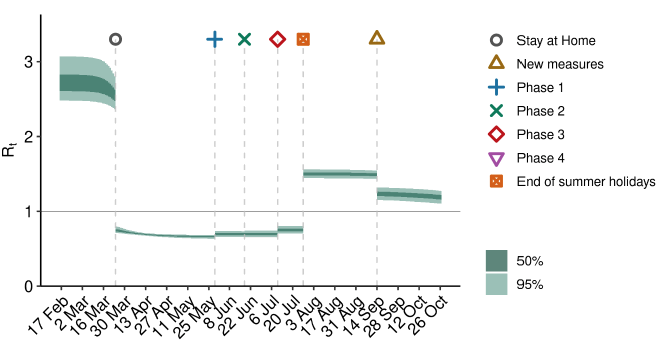
Source: Scottish Government modelled estimates using Imperial College model code; actual data from https://www.nrscotland.gov.uk/statistics-and-data/statistics/statistics-by-theme/vital-events/general-publications/weekly-and-monthly-data-on-births-and-deaths/deaths-involving-coronavirus-covid-19-in-scotland
The various groups which report to the Scientific Pandemic Influenza Group on Modelling (SPI-M) use different sources of data in their models (i.e. deaths, hospital admissions, cases) so their estimates of R are also based on these different methods. SAGE's consensus view across these methods, as of 4 November, was that the value of Rt in Scotland was slightly above 1, between 0.9 and 1.1. The R value estimated by the Scottish Government is within the consensus range (Figure 2).
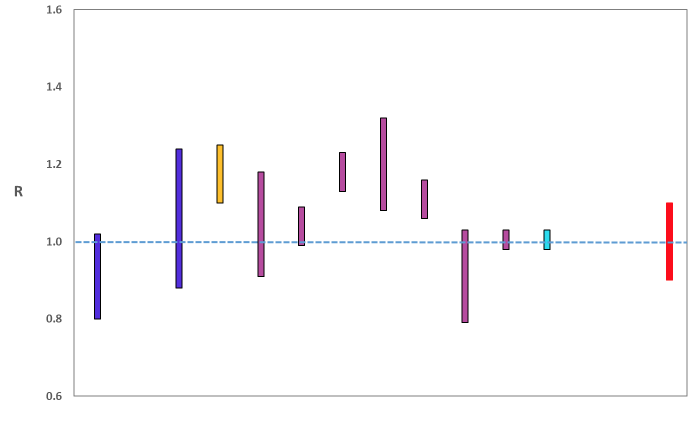
Source: Scientific Advisory Group for Emergencies (SAGE).
On 2 November, Public Health Scotland recorded 999[1] positive new cases, with 7,746 positive new cases over the week of 25 – 31 October.
The various groups which report to the Scientific Pandemic Influenza Group on Modelling (SPI-M) use different sources of data in their models to produce estimates of incidence (Figure 3). SPI-M's consensus view across these methods, as of 4 November, was that the incidence of new daily infections in Scotland was between 90 and 216 new infections per 100,000. This equates to between 4,900 and 11,800 people becoming infected each day in Scotland.
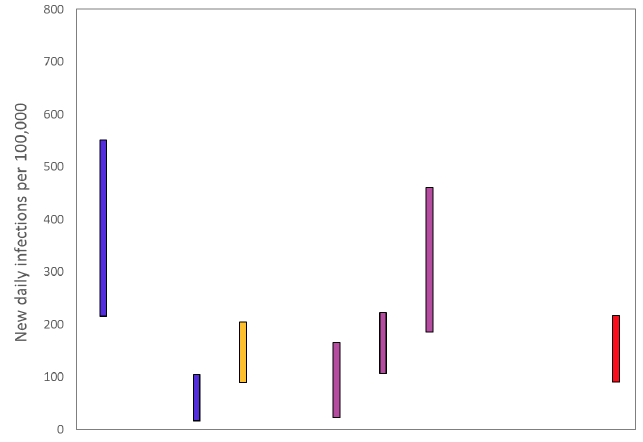
Source: Scientific Pandemic Influenza Group on Modelling (SPI-M).
The consensus from SAGE for this week is that the growth rate in Scotland is between -1% and +2% per day. Last week the growth rate was in the range +1% to +5%.
The spread of the epidemic can be expressed in terms of the length of time it takes for numbers of new daily cases to double. Doubling times were provided by SPI-M on 28 October. The consensus estimated doubling time for Scotland was at least 45 days.
Figure 4 shows the epidemiological model forecasts of daily deaths produced by the Scottish Government, given the present set of interventions. This measure of the epidemic is forecast to increase in the weeks ahead.
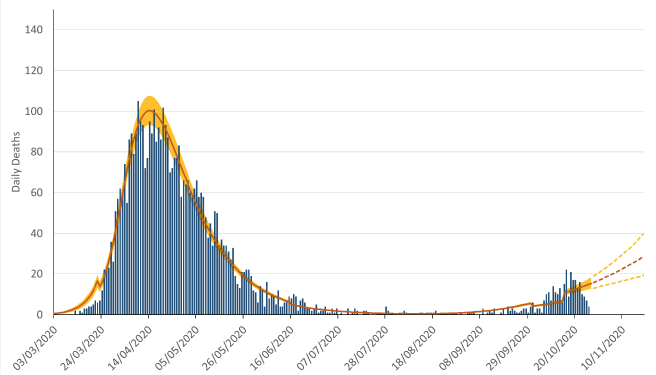
Source: Scottish Government modelled estimates using Imperial College model code; actual data from https://www.nrscotland.gov.uk/statistics-and-data/statistics/statistics-by-theme/vital-events/general-publications/weekly-and-monthly-data-on-births-and-deaths/deaths-involving-coronavirus-covid-19-in-scotland
The logistical model developed by Scottish Government to assess implications for health care demand (see previous Research Findings) has been adapted to produce a short/medium-term predictions of infections.
The following two week prediction uses this model to extend the estimated number of infections from the Imperial College model, in a manner that fits with the estimated number of actual infections, adjusting people who have tested positive to account for asymptomatic and undetected infections.
Figure 5 shows a "better scenario", which assumes the Rt value under the reset measures announced on 7 October will be maintained, and a "worse scenario", which assumes that transmission has increased again after schools returned from half-term.
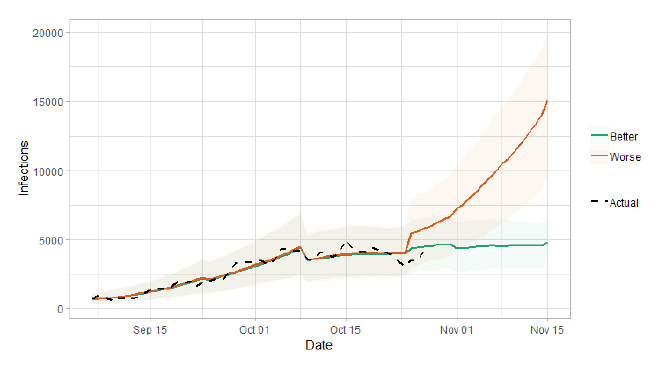
What the modelling tells us about Hospital bed and ICU bed demand
Figure 6 shows the impact of the better and worse scenarios on the number of people in hospital.
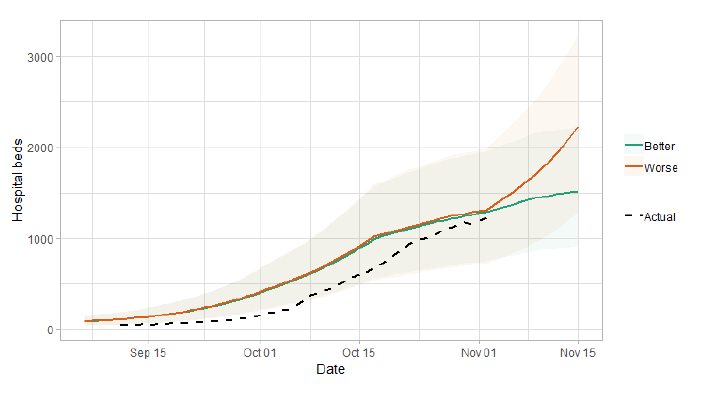
Figure 7 shows the impact of the better and worse scenarios on ICU bed demand. As things stand, the bed demand estimates lie consistently above the actual number of people in ICU, though it is well within the prediction interval.
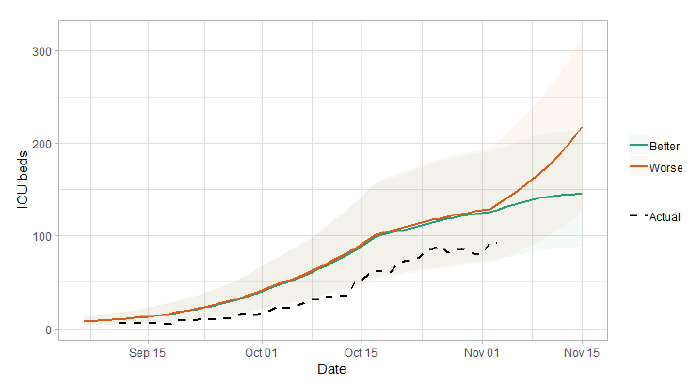
What we know about how people's contact patterns have changed
It is now possible for us to estimate how much contact people in Scotland have with each other, with a good degree of accuracy. This provides an update of the modelled results presented in issue 24 using methodologies developed by the London School of Hygiene and Tropical Medicine. The modelling is based on a survey asking about where respondents have been and how many contacts they met in a given week.
The average number of contacts per day are approximately two thirds higher than the level at the beginning of Stay-at-home-advice, and around half the level pre-Stay-at-home-advice (UK comparison 10.8). The number of contacts has fallen significantly in the last two weeks (down around 14%), and is down 34% since the end of August (Figure 8) and is lower than the level immediately before the schools went back (down around 15%) Interactions between age groups have decreased since the end of August. This suggests the rule of six and restrictions on households meeting and also further restrictions have had a noticeable effect. Older people generally have fewer reported contacts than younger people, but the difference is largely from work and school contacts, rather than in the home or in other settings. There is a drop off in how many people are visiting different locations, particularly in the pubs category.
The Scottish Survey is split into two sample groups, Panel A and Panel B. These are updated every two weeks for each panel (alternating). The following visualisations combine both sample groups and show how their mean contacts change over time (See technical annex in issue 18 of the Research Findings). Data covering the periods from 12th – 19th August (Panel B week 1) and 24th – 30th September (Panel B week 4), have been removed due to anomalous entries.
There was a significant increase when schools went back, from 6 to 8 average contacts, however both Panels A and B show a consistent reduction in the number of mean contacts between the end of August and the end of October. In the last two weeks, mean contacts have reduced by 14%, though they remain higher than the 2.8 contacts per person for the UK as a whole at the beginning of the Stay-at-home-advice.
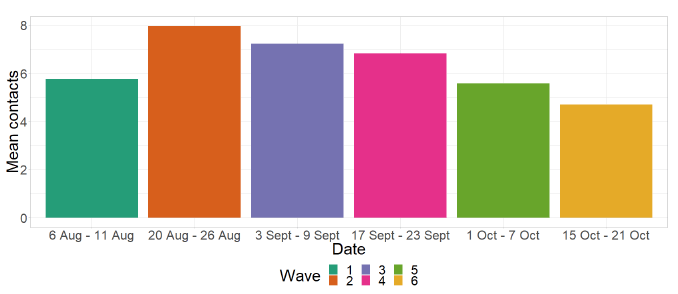
Figure 8 (panel A) displays an initial increase in mean contacts when schools reopened then a downward trend afterwards. This downward trend is also borne out in panel B, as seen in Figure 9.
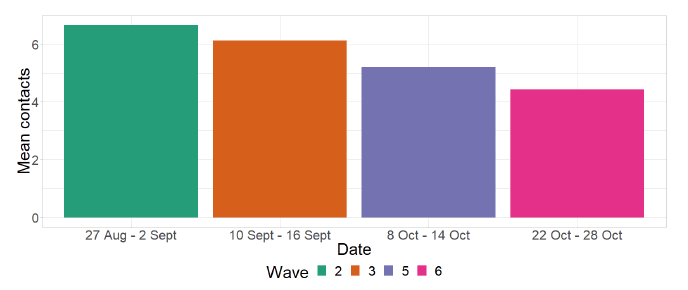
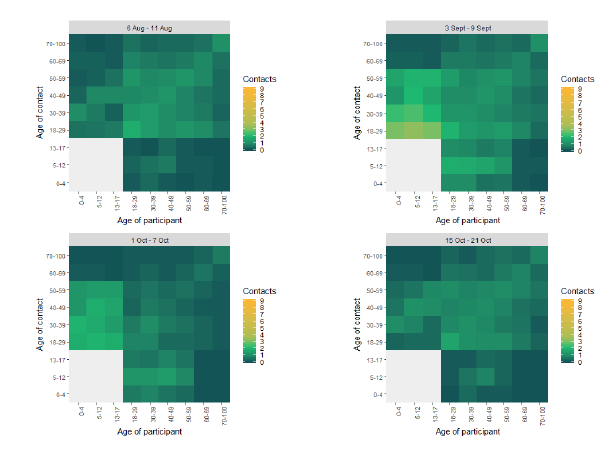
The heatmap in Figure 10 shows the mean contacts by age group over time from the start of August to mid-October. This illustrates that individuals initially had an increase in mean contacts, particularly younger age groups, when schools reopened (August to September). However, this has steadily reduced and all age groups currently have less contact with other age groups compared to the start of August.
For both panels A and B, contacts are fewer in older age groups, with the oldest age group having similar levels of contact to the UK at the beginning of the Stay-at-home-advice (2.0 from CoMix), this remains consistent with the previous survey. The youngest age group also shows similar levels of contacts to the UK average prior to the beginning of the Stay-at-home-advice (12.1 from POLYMOD[2]) until mid-September, this fell significantly at the start of October and remains the same for the most recent survey. This can be seen in Figure 11 for panel A and Figure 12 for panel B.
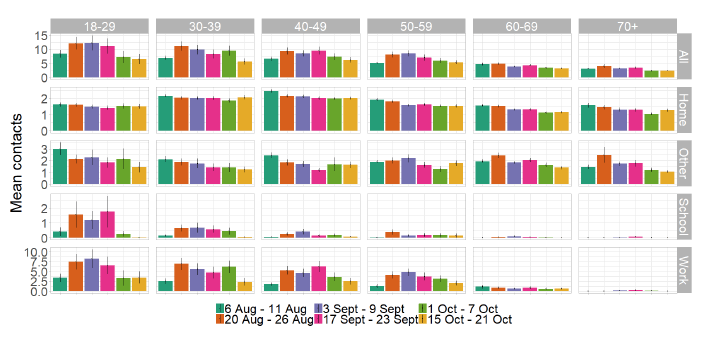
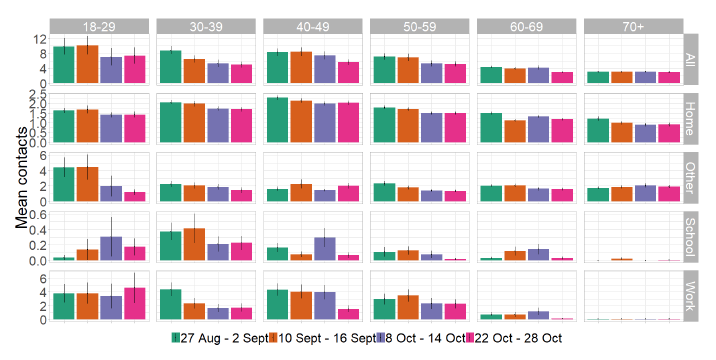
Overall contacts for both panels show a downward trend over time. The main difference between age groups is that younger people are having more contacts at work and at school. However, the latest reporting week shows a significant drop in work contacts for the 30-39 and 40-49 age groups. In both panels there is an initial increase in school contacts across all age groups as terms commences in late August, followed by a decrease in mid/late October which coincides with mid-term holidays. With the exception of the 18-29 age group in panel B, there has been a significant drop off in contacts made at work across all age groups in both panels from the start of September. There is little difference in contacts reported in "other" settings but a slight gradual decrease can be seen in the 30-39 age group and more significantly in the 60-69 age group for both panels from August to October. The youngest and oldest age groups also report similar contacts in the home (the middle age groups report higher contacts in the home than the youngest and oldest) as set out in Figures 11 and 12.
As Figure 13 shows, the biggest change in behaviour has been the drop off in the proportion of people that have visited other people's home since the commencement of the survey until the end of October. The most significant decrease in most recent weeks can be seen in the number of people visiting pubs which will be largely due to the restrictions placed on hospitality, introduced on 9th October.
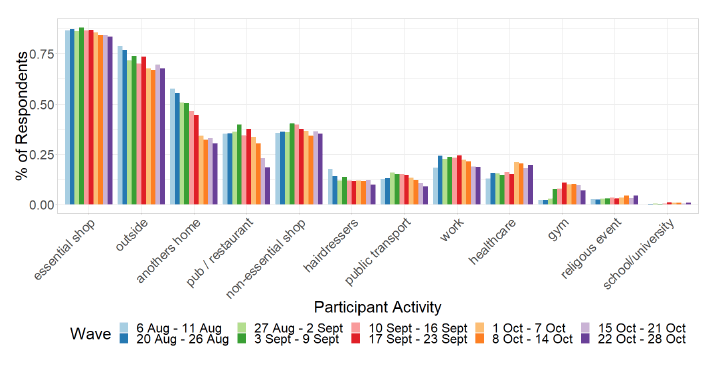
What we know about which regions are experiencing high levels of Covid
We use modelling based on Covid cases and deaths, conducted by Imperial College London, to give us an indication of whether a local authority is experiencing high levels of Covid. An area is defined as a hotspot if the two week prediction of cases (positive tests) per 100K population are predicted to exceed a threshold, e.g. 500 cases. See technical annex in issue 24.
Modelled rates per 100K (Figure 14) indicate that by the week of 15 - 21 November, 22 local authorities have at least a 75% probability of exceeding 50 cases, 18 of those have at least a 75% probability of exceeding 100 cases and none have at least a 75% probability of exceeding 300 (or 500) cases.
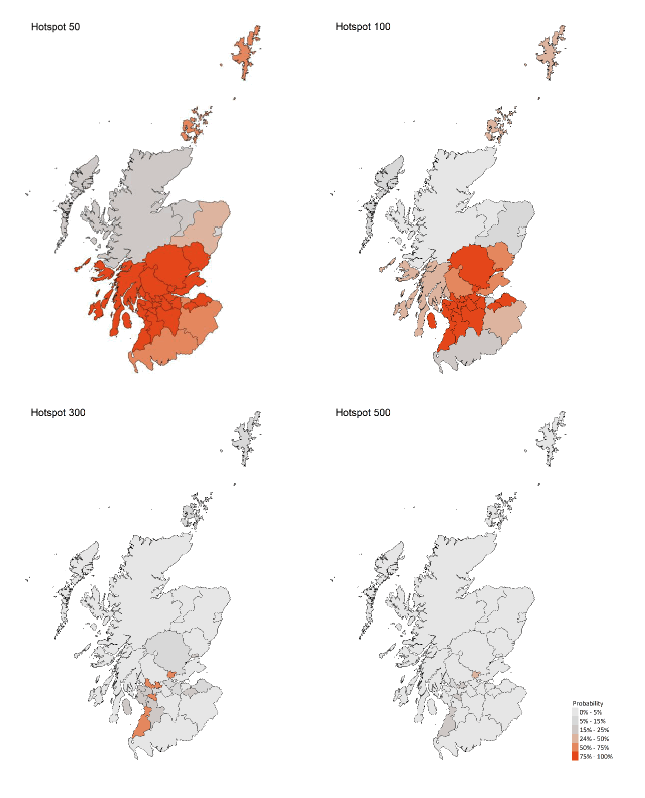
What next?
The Scottish Government continues to work with a number of academic modelling groups to develop other estimates of the epidemic in Scotland. This includes updates to the forecast of the number of hospitalisations and the pattern of positive tests in different age and clinical risk groups which were reported in issue 23. This has not been included in this issue as the proportions have changed very little this week. We will provide an update when we see a significant change.
The modelled estimates of the numbers of new cases and infectious people will continue to be provided as measures of the epidemic as a whole, along with measures of the current point in the epidemic such as exceedance. Rt and growth rate will also be provided. Further information can be found at https://www.gov.scot/coronavirus-covid-19.
Technical Annex
Table 1 provides the underlying data used in the section above on "What we know about which regions are experiencing high levels of Covid". It is provided by Imperial College London.
| LA | P(Cases>500) | P(Cases>300) | P(Cases>100) | P(Cases>50) |
|---|---|---|---|---|
| Aberdeen City | 0% | 0% | 2% | 10% |
| Aberdeenshire | 0% | 0% | 5% | 28% |
| Angus | 0% | 2% | 54% | 86% |
| Argyll and Bute | 0% | 2% | 45% | 80% |
| City of Edinburgh | 0% | 0% | 7% | 53% |
| Clackmannanshire | 38% | 71% | 97% | 99% |
| Dumfries and Galloway | 0% | 0% | 23% | 65% |
| Dundee City | 2% | 24% | 92% | 99% |
| East Ayrshire | 2% | 16% | 83% | 98% |
| East Dunbartonshire | 20% | 59% | 97% | 100% |
| East Lothian | 1% | 11% | 81% | 95% |
| East Renfrewshire | 18% | 64% | 99% | 100% |
| Falkirk | 0% | 9% | 87% | 98% |
| Fife | 0% | 0% | 58% | 95% |
| Glasgow City | 0% | 13% | 99% | 100% |
| Highland | 0% | 0% | 1% | 18% |
| Inverclyde | 2% | 23% | 89% | 98% |
| Midlothian | 1% | 15% | 84% | 98% |
| Moray | 0% | 0% | 4% | 20% |
| Na h-Eileanan Siar | 0% | 1% | 7% | 20% |
| North Ayrshire | 3% | 17% | 81% | 96% |
| North Lanarkshire | 0% | 1% | 83% | 99% |
| Orkney Islands | 3% | 8% | 36% | 55% |
| Perth and Kinross | 2% | 10% | 77% | 96% |
| Renfrewshire | 1% | 23% | 93% | 99% |
| Scottish Borders | 0% | 1% | 27% | 67% |
| Shetland Islands | 2% | 7% | 33% | 52% |
| South Ayrshire | 18% | 62% | 98% | 100% |
| South Lanarkshire | 0% | 2% | 79% | 99% |
| Stirling | 0% | 3% | 55% | 88% |
| West Dunbartonshire | 10% | 53% | 98% | 100% |
| West Lothian | 0% | 6% | 81% | 98% |
Tables 2 and 3 provide the underlying data used in the section above on “What the modelling tells us about Hospital bed and ICU bed demand”. They are based on modelling undertaken by Scottish Government (for more information see research findings issue 1).
The purpose of these predictions is to support a decision on what measures are needed in different parts of Scotland. As part of the medium term modelling, these predictions are not intended as short term forecasts (less than two weeks, for which management information is more appropriate), but the initial weeks are provided for completeness.
As the upper end of the range is presented for each health board, the aggregate cannot be used as a prediction of the number of beds required in Scotland as a whole.
| Area | Double Capacity | 09/11/20 | 16/11/20 | 23/11/20 | 30/11/20 | 07/12/20 | 14/12/20 |
|---|---|---|---|---|---|---|---|
| Ayrshire & Arran | 20 | 8 - 15 | 9 - 16 | 9 - 16 | 10 - 17 | 11 - 19 | 13 - 21 |
| Borders | 10 | <5 | <5 | <5 | <5 | <5 | <5 |
| Dumfries & Galloway | 8 | <5 | <5 | <5 | <5 | <5 | <5 |
| Fife | 20 | <19 | <20 | <20 | <21 | 5 - 22 | 6 - 25 |
| Forth Valley | 14 | 5 - 15 | 5 - 15 | 6 - 16 | 6 - 17 | 7 - 18 | 8 - 21 |
| Grampian | 32 | <5 | <6 | <6 | <6 | <6 | <7 |
| Greater Glasgow & Clyde | 76 | 19 - 52 | 20 - 54 | 21 - 56 | 23 - 59 | 25 - 64 | 29 - 73 |
| Highland | 16 | <5 | <5 | <5 | <5 | <5 | <5 |
| Lanarkshire | 40 | 15 - 36 | 16 - 37 | 17 - 38 | 19 - 40 | 21 - 44 | 24 - 50 |
| Lothian | 55 | 8 - 16 | 9 - 17 | 9 - 18 | 10 - 18 | 11 - 20 | 13 - 23 |
| Orkney* | 0 | <5 | <5 | <5 | <5 | <5 | <5 |
| Shetland* | 0 | <5 | <5 | <5 | <5 | <5 | <5 |
| Tayside | 22 | <11 | 5 - 10 | 5 - 10 | 5 - 11 | 6 - 12 | 7 - 14 |
| Western Isles | <5 | <5 | <5 | <5 | <5 | <5 | <5 |
Values in this table give an interval, actual occupancy could be higher or lower.
| Area | Capacity | 12/11/20 | 19/11/20 | 26/11/20 | 03/12/20 | 10/12/20 | 17/12/20 |
|---|---|---|---|---|---|---|---|
| Ayrshire & Arran | 203 | 72 - 159 | 78 - 198 | 83 - 249 | 91 - 260 | 104 - 280 | 123 - 311 |
| Borders | 118 | <10 | <12 | <15 | <16 | <17 | <19 |
| Dumfries & Galloway | 90 | <19 | <24 | <30 | 5 - 30 | 5 - 33 | 6 - 36 |
| Fife | 322 | 38 - 70 | 41 - 87 | 44 - 109 | 49 - 114 | 55 - 123 | 65 - 137 |
| Forth Valley | 144 | 33 - 86 | 35 - 107 | 38 - 135 | 41 - 141 | 47 - 152 | 56 - 169 |
| Grampian | 295 | 20 - 36 | 22 - 44 | 23 - 56 | 26 - 58 | 29 - 63 | 35 - 70 |
| Greater Glasgow & Clyde | 1,070 | 328 - 592 | 355 - 738 | 380 - 928 | 417 - 969 | 474 - 1043 | 561 - 1160 |
| Highland | 176 | <20 | <25 | <31 | <32 | <35 | 5 - 37 |
| Lanarkshire | 455 | 161 - 309 | 175 - 385 | 187 - 484 | 205 - 506 | 233 - 545 | 275 - 606 |
| Lothian | 487 | 103 - 214 | 111 - 267 | 119 - 336 | 130 - 351 | 148 - 378 | 175 - 420 |
| Orkney | 28 | <5 | <5 | <5 | <5 | <5 | <5 |
| Shetland | 64 | <5 | <5 | <5 | <5 | <5 | <5 |
| Tayside | 172 | 43 - 102 | 47 - 127 | 50 - 160 | 55 - 167 | 63 - 180 | 74 - 200 |
| Western Isles | 32 | <5 | <5 | <5 | <5 | <5 | <5 |
Values in this table give an interval, actual occupancy could be higher or lower.
Contact
There is a problem
Thanks for your feedback